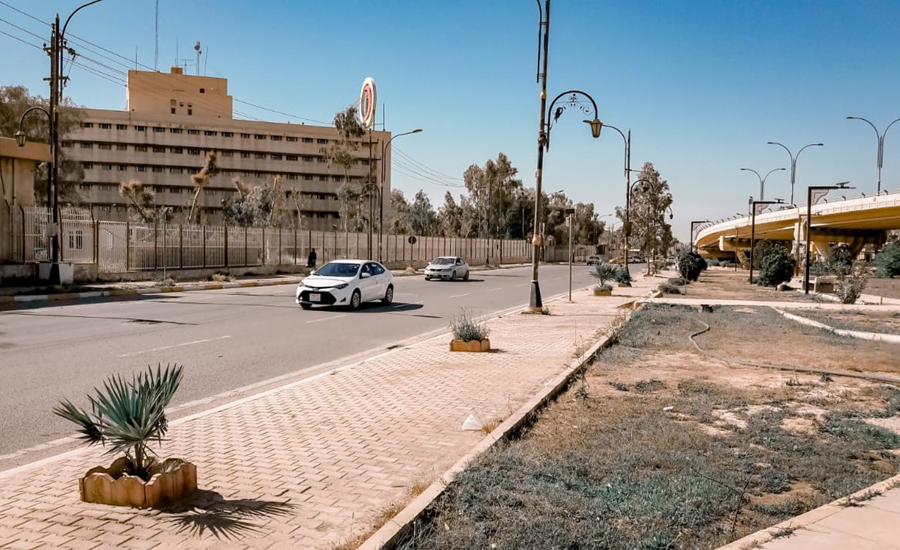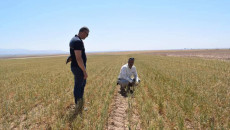The Director of Agriculture of Kirkuk, said that they plan to build a green belt around Kirkuk in order to prevent the effects of dust, for this purpose, stressed the need for 3.5 billion dinars.
In mid-May, a wave of heavy sandstorm covered the Iraqi provinces, causing a public holiday in most provinces, flights were halted and final exams were postponed in various educational institutions, including Kirkuk province.
A thick cloud of dust enveloped in an orange glow and blanketed Kirkuk, the disputed territories and other cities including the Shiite shrine city of Najaf to the south, and Sulaymaniyah in the semi-autonomous northern Kurdistan Region of Iraq KRI.
Zahir Ali, director of agriculture in Kirkuk, told KirkukNow, “We decided to create a green belt to prevent dust and affect the city. According to the plan, the belt will extend from southwest to southeast of Kirkuk around the ring road of Kirkuk, 30 to 40 meters wide, four to five rows will be planted.”
"Our duty as Kirkuk agriculture is to identify the land, identify the trees and plant it. The duty of the Kirkuk administration is to provide the budget, for this purpose, we have asked for a 3.5 billion (Dinars- $2.4 million) has been requested and approved," he said.
The efforts spent in the last ten years by Kirkuk administration to boost greenery in the city have sharply failed as greenery is diminishing due to lack of adequate budget for irrigation and maintenance, making the environment of Kirkuk dusty and untidy, a report by KirkukNow found out in April 2021.
End of 2010, local officials of Kirkuk municipality, in charge of public services such as greenery maintenance and garbage collection, have told KirkukNow they will riase rate of greenery. In 2014, they declared their plan to surround Kirkuk with a green belt to contain dust.
Years following these plans and efforts, the current rate of greenery is only 2% while back in 2017 it was double.
Located 238 kilometers north of Baghdad, the oil-rich city of Kirkuk is an ethnically mixed province for 1.7 million Kurds, Arabs, and Turkmen, Muslims, Christians and Kaka'is. It has long been at the center of disputes between Baghdad and the Erbil.
3.5 billion has been requested and approved, what remains is the decision to implement by the Kirkuk administration
The plan dates back to days ahead of the last two massive waves of duststorm that swept Iraq this spring, the first wave alone on May 17, more than 700 people were hospitalized for respiratory problems in Kirkuk.
"The main purpose of the green belt is to prevent dust from entering the city and reduce its impact on the city and citizens," director of Kirkuk agriculture added.
"After the completion of the project, both municipalities and public works will supervise and monitor it," Ali added.
"We will plant trees that are resistant to water shortages, heat and dust and are environmentally friendly.”
There are about 184 public gardens in Kirkuk few of it are several acres while others are smaller. Besides, there are 81 medians, range from 1-5 km long where trees are planted yet all about to dry out.
Local authorities blame absence of proper human and material resources to administer this public service alike others like education, healthcare and waste collection.
Kirkuk Mayor Faraidoon Adel said earlier that their biggest problem in increasing the amount of greenery and even serving the current public green areas is scarcity of water, a problem Iraq is facing in the last few years due to winter poor rainfalls, and absence of adequate budget and manpower.
At least 10,000 people were admitted to hospitals needing treatment for respiratory difficulties in the last two sandstorms, as over 20 sandstorms in 2022 hit Iraq which has been battered by soil degradation, intense droughts and low rainfall linked to climate change without any remarkable efforts to counter desertification threatening Iraq and other countries in the region.






